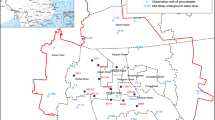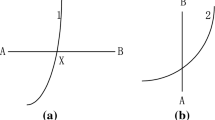Abstract
Traditional land subsidence indices primarily describe the characteristics of land subsidence at a given site, but such indicators cannot satisfy the requirements for effective land management. We propose a new index system called the point-line-area-volume (PLAV) index system, designed to facilitate efficient description of the geometric characteristics of land subsidence. The system features four indices: the (1) point index system, which describes land subsidence at a site; (2) line index system, which depicts heterogeneous land subsidence between two sites; (3) area index system, which is an indicator of surface land subsidence; and (4) volume index system (VIS), which elucidates land subsidence in terms of soil volume loss. The analytic hierarchy process (AHP) indicates that VIS is the best index system among the four. Additionally, we introduce comprehensive index I, which describes the overall characteristics of land subsidence. The weights of the PLAV indices are calculated by the AHP method. The index system is used to determine the land subsidence characteristics of Ningbo, Zhejiang Province, China and to evaluate the potential hazards for the study site.






Similar content being viewed by others
References
Abidin HZ, Djaja R, Darmawan D, Hadi S, Akbar A, Rajiyowiryono H, Sudibyo Y, Meilano I, Kasuma MA, Kahar J, Subarya C (2001) Land subsidence of Jakarta (Indonesia) and its geodetic monitoring system. Nat Hazards 23(2–3):365–387
Amin A, Bankher K (1997) Causes of land subsidence in the Kingdom of Saudi Arabia. Nat Hazards 16(1):57–63
Antonelli M, Mollena P, Giambastini B, Bishop K, Caruro L, Minchic A, Pellegrini L, Sabia M, Udazzi E, Gabianelli G (2008) Salt water intrusion in the coastal aquifer of southern PoPlain, Italy. xHydrogeol J 16(8):1541–1556
Baldi P, Casula G, Cenni N, Loddo F, Pesci A (2009) GPS-based monitoring of land subsidence in the Po Plain (Northern Italy). Earth Planet Sci Lett 288(1–2):204–212
Bell FG, Cripps JC, Culshaw MG (1986) A review of the engineering behavior of soils and rocks with respect to groundwater. In: groundwater in engineering geology. Geol Soc Eng Geol Spec Publ 3:1–23
Calderhead AI, Martel R, Alasset PJ, Rivera A, Garfias J (2010) Land subsidence induced by groundwater pumping, monitored by D-InSAR and field data in the Toluca Valley, Mexico. Can J Remote Sens 36(1):9–23
Cigna F, Osmanoglu B, Cabral-Cano E, Dixon TH, Avila-Olivera JA, Garduno-Monroy VH, DeMet C, Wdowinski S (2012) Monitoring land subsidence and its induced geological hazard with synthetic aperture radar Interferometry: a case study in Morelia, Mexico. Remote Sens Environ 117:146–161
Deck O, Verdel T, Salmon R (2009) Vulnerability assessment of mining subsidence hazards. Risk Anal 29(10):1381–1394
Dehghani M, Zoej MJV, Entezam I, Mansourian A, Saatchi S (2009) InSAR monitoring of progressive land subsidence in Neyshabour, northeast Iran. Geophys J Int 178(1):47–56
Don NC, Araki H, Yamanishi H, Koga K (2005) Simulation of groundwater flow and environmental effects resulting from pumping. Environ Geol 47(3):361–374
Ferronato M, Gambolati G, Teatini P, Bau D (2003) Stochastic compressibility in land subsidence modeling. In: 16th ASCE Engineering Mechanics Conference, University of Washington, Seattle, 16–18 July 2003
Galloway DL, Burbey TJ (2011) Review: regional land subsidence accompanying groundwater extraction. Hydrogeol J 19(8):1459–1486
Gutiérrez F, Guerrero J, Lucha P (2008) Quantitative sinkhole hazard assessment. A case study from the Ebro Valley evaporite alluvial karst (NE Spain). Nat Hazards 45(2):211–233
Hoffmann J, Galloway DL, Zebker HA (2003) Inverse modeling of interbed storage parameters using land subsidence observations, Antelope Valley, California. Water Resour Res 39(2):1231
Hou CS, Hu JC, Shen LC, Wang JS, Chen CL, Lai TC, Huang C, Yang YR, Chen RF, Chen YG, Angelier J (2005) Estimation of subsidence using GPS measurements, and related hazard: the Pingtung Plain, southwestern Taiwan. Comptes Rendus Geosci 337(13):1184–1193
Hu BB, Zhou J, Wang J, Chen ZL, Wang DQ, Xu SY (2009) Risk assessment of land subsidence at Tianjin coastal area in China. Environ Earth Sci 59:269–276
Kim JM (2005) Three-dimensional numerical simulation of fully coupled groundwater flow and land deformation in unsaturated true anisotropic aquifers due to groundwater pumping. Water Resour Res 41(1):W01003. doi:10.1029/2003WR002941
Loupasakis C, Rozos D (2009) Finite-element simulation of land subsidence induced by water pumping in Kalochori village, Greece. Q J Eng Geol Hydrogeol 42:369–382
Luo YH, Zhang L, Zhang YC (1998) Geological disaster risk assessment method. Geological Publishing House, Beijing (in Chinese)
Marfai MA, King L (2007) Monitoring land subsidence in Semarang, Indonesia. Environ Geol 53(3):651–659
Marker BR (2010) Review of approaches to mapping of hazards arising from subsidence into cavities. Bull Eng Geol Environ 69(2):159–183
Mazzotti S, Lambert A, Van der Kooij M, Mainville A (2009) Impact of anthropogenic subsidence on relative sea-level rise in the Fraser River delta. Geol 37(9):771–774
Netease (2012) Land subsidence occurs in more than 50 cities in China. http://news.163.com/12/0221/01/7QOGNIVJ0001124J.html Last accessed 21/02/2012 (in Chinese)
Ortiz ZD, Ortega GA (2010) Evolution of long-term land subsidence near Mexico City: review, field investigations, and predictive simulations. Water Resour Res 46:W01513. doi:10.1029/2008WR007398
Phien-wej N, Giao PH, Nutalaya P (1998) Field experiment of artificial recharge through a well with reference to land subsidence control. Eng Geol 50(1–2):187–201
Pipkin BW (1994) Geology and the environment. West Publishing Company, United States of America
Saaty TL (2008) Decision making for leaders: the analytic hierarchy process for decisions in a complex world. RWS Publications, Pittsburgh
Sahu P, Sikdar PK (2011) Threat of land subsidence in and around Kolkata City and East Kolkata Wetlands, West Bengal, India. J Earth Syst Sci 120(3):435–446
Shearer TR (1998) A numerical model to calculate land subsidence, applied at Hangu in China. Eng Geol 49(2):85–93
Shen SL, Xu YS (2011) Numerical evaluation of land subsidence induced by groundwater pumping in Shanghai. Can Geotech J 48(9):1378–1392
Shen SL, Xu YS, Hong ZS (2006) Estimation of land subsidence based on groundwater flow model. Mar Georesour Geotechnol 24(2):149–167
Stecchi F, Antonellini M, Gabbianelli G (2009) Curvature analysis as a tool for subsidence-related risk zones identification in the city of Tuzla (BiH). Geomorphology 107(3–4):316–325
Strozzi T, Wegm¨uller U, Tosi L, Bitelli G, Spreckels V (2001) Land subsidence monitoring with differential SAR interferometry. Photogramm Eng Remote Sens 67(11):1261–1270
Tosi L, Teatini P, Carbognin L, Frankenfield J (2007) A new project to monitor land subsidence in the northern Venice coastland (Italy). Environ Geol 52(5):889–898
United Nations, International Strategy for Disaster Reduction (ISDR) (2002) Living with risk: a global review of disaster reduction initiatives (preliminary version). UN ISDR, Geneva
Ustun A, Tusat E, Yalvac S (2010) Preliminary results of land subsidence monitoring project in Konya closed basin between 2006 and 2009 by means of GNSS observations. Nat Hazards Earth Syst Sci 10(6):1151–1157
Waltham T, Bell FG, Culshaw MG (2005) Sinkholes and subsidence: karst and cavernous rocks in engineering and Construction. Praxis Publishing Ltd, Chichester
Wang GL (2006) Preliminary studies on dangerous grading standard of land-subsidence. Shanghai Geol 4:39–43 (in Chinese)
Wang GL, Li GL (2007) Quantitative analysis of the danger levels of ground subsidence. City Geol 2(2):19–26 (in Chinese)
Wikipedia (2011) Analytic hierarchy process. http://en.wikipedia.org/wiki/Analytic_Hierarchy_Process Last accessed 28/10/2011
Wu QH (2008) The research on assessment methods of regional land subsidence. Bull Surv Mapp 28(5):40–41 (in Chinese)
Xu YS, Shen SL, Cai ZY, Zhou GY (2008) The state of land subsidence and predication approaches due to groundwater withdrawal in China. Nat Hazards 45:123–135
Xu YS, Shen SL, Du YJ (2009) Geological and hydrogeological environment in Shanghai with geohazards to construction and maintenance of infrastructures. Eng Geol 109(3–4):241–254
Xue YQ, Zhang Y, Ye SJ (2003) Land subsidence in china and its problems. Quat Sci 23(6):585–593 (in Chinese)
Ye JN, Zheng XX, YS H (2010) Characteristic analysis of land subsidence and monitoring in the planning area of the Ningbo rail traffic. Hydrogeol Eng Geol 37(3):107–111 (in Chinese)
Zhang YJ, Deng XY, Wei DJ, Deng Y (2012) Assessment of e-commerce security using AHP and evidential reasoning. Expert Syst Appl 39(3):3611–3623
Acknowledgments
This work was supported by the National Natural Science Foundation of China (grant no. 41072205) and the Shanghai Natural Science Foundation of China (grant no. 10ZR1431500).
Author information
Authors and Affiliations
Corresponding author
Rights and permissions
About this article
Cite this article
Wang, J., Gu, X., Jiang, Y. et al. Point-line-area-volume index system of land subsidence and application in Ningbo, China. Nat Hazards 69, 2197–2214 (2013). https://doi.org/10.1007/s11069-013-0801-0
Received:
Accepted:
Published:
Issue Date:
DOI: https://doi.org/10.1007/s11069-013-0801-0




